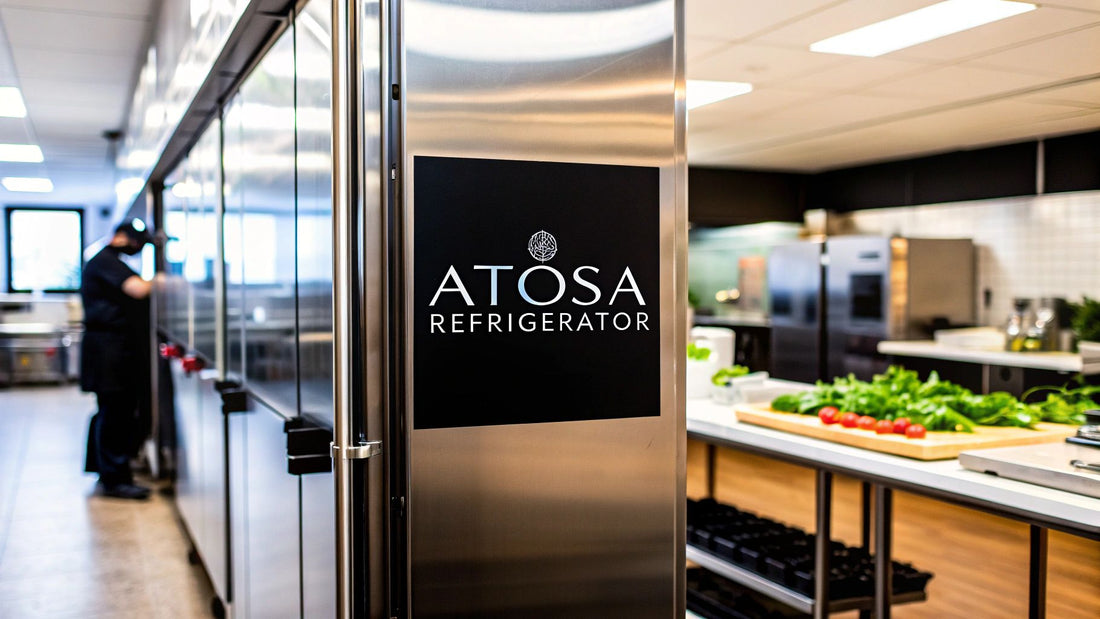
Find the Best Atosa Refrigerator for Your Kitchen
Share
When your restaurant's entire reputation hinges on freshness, the refrigeration you choose is one of the most critical decisions you'll make. An Atosa refrigerator has become a go-to for countless chefs and kitchen managers, and for good reason. They strike that perfect balance between tough, reliable performance and a price point that doesn't break the bank, making them a smart, practical choice for any busy commercial kitchen.
These units are built from the ground up for the chaos of the culinary world, delivering the durability, cooling power, and food safety standards you simply can't compromise on. In this guide, we'll dive into what makes Atosa a standout brand, helping you stay informed on industry trends so you can choose the right equipment to elevate your kitchen.
Why Smart Kitchens Run on Atosa Refrigeration
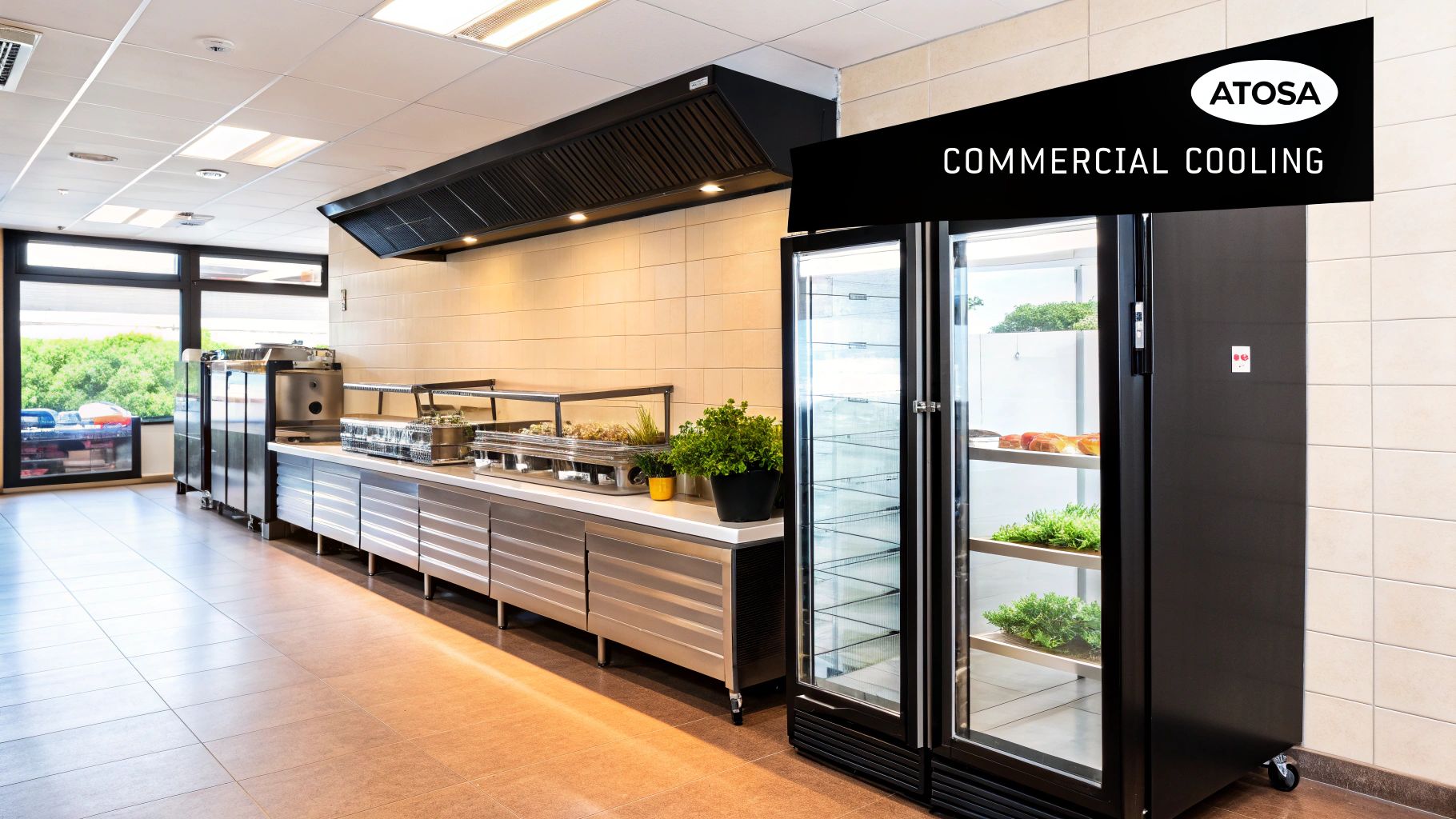
In a commercial kitchen, every single piece of equipment has to pull its weight. You need workhorses, not show ponies—tools that perform flawlessly under pressure, shift after shift. This is exactly where an Atosa refrigerator proves its worth. It’s more than just a cold box; it’s an insurance policy for your most valuable assets: your ingredients.
Think of it as the silent, unsung hero of your back-of-house. While your chefs are plating masterpieces and servers are hustling, your refrigerator is quietly holding the precise temperature needed to keep produce snappy, proteins safe, and dairy fresh. A failure isn't just a matter of spoiled food. It's lost money, a hit to your reputation, and a potential run-in with the health inspector.
Engineered for the Kitchen Battlefield
The people at Atosa get it. They know a commercial kitchen is a battlefield of heat, steam, and constant motion. That's why their refrigerators are built with high-grade stainless steel that can take a beating—resisting the dents, spills, and relentless use that come with the territory. This tough-as-nails construction means your investment will last for years.
But it’s not just about being tough. These units are designed with the daily grind in mind.
- Powerful Cooling Systems: Atosa packs its refrigerators with heavy-duty compressors and smart air circulation. This means they hold their temperature, even when the doors are constantly being swung open during a hectic dinner service.
- Food Safety Compliance: Every model is built to meet or exceed NSF standards for food safety. That's one less thing for you to worry about. You can trust that your inventory is stored in a fully compliant environment.
- User-Focused Design: Little things make a big difference. Self-closing doors help prevent energy waste (and staff mistakes!), while adjustable, heavy-duty shelves can handle everything from lightweight herb trays to massive stock pots.
An Atosa refrigerator isn’t just an appliance; it’s a foundational part of your kitchen’s ecosystem. It protects your inventory, guarantees food safety, and helps your whole operation run smoother so you can focus on what really matters—the food.
A Recognized Player in a Growing Market
Atosa has earned its spot as a major force in commercial refrigeration, especially with its popular reach-in models. They've become a key player in a global market that’s expanding right alongside the foodservice industry itself. As more restaurants and food businesses open or upgrade their kitchens, the demand for reliable, efficient refrigeration just keeps climbing. Staying informed about these industry trends helps you make smarter purchasing decisions.
To give you a clearer picture, here’s a quick breakdown of what sets Atosa apart.
Atosa Refrigerator Core Benefits At a Glance
| Feature Category | Benefit for Your Kitchen |
|---|---|
| Construction | High-grade stainless steel stands up to the daily abuse of a busy kitchen, protecting your investment. |
| Cooling Power | Robust compressors maintain steady temperatures, ensuring food safety even during peak hours. |
| Energy Efficiency | Features like self-closing doors and efficient insulation help keep your utility bills in check. |
| Compliance | Built to meet NSF standards, giving you complete peace of mind during health inspections. |
| Practical Design | Adjustable shelving and easy-to-use digital controls make daily operations simpler for your staff. |
| Value | Delivers professional-grade performance and durability at a competitive price point. |
Atosa's growth in this competitive field isn't an accident; it's a testament to the brand's reputation for quality. If you want to dig deeper into the industry trends, you can find detailed insights on the reach-in refrigerator market online. Choosing Atosa means aligning your kitchen with a brand that has proven its staying power and performance where it counts.
What Makes an Atosa Refrigerator Tick? A Look Under the Hood
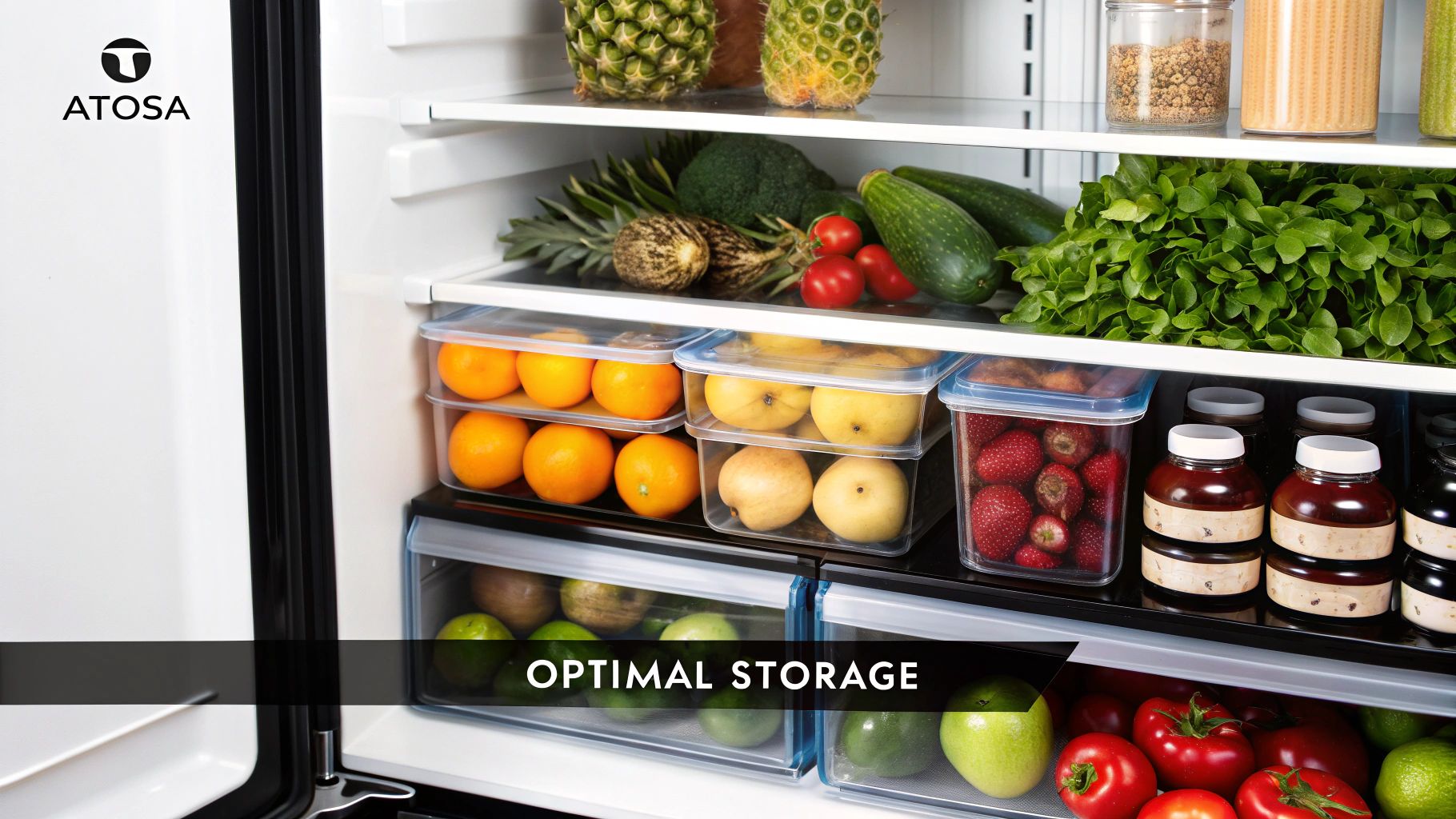
When the ticket machine is buzzing nonstop and the kitchen is in full swing, your refrigeration shouldn't even be on your mind. An Atosa refrigerator isn’t just a cold box; it’s a collection of smart, practical features built to handle the brutal pace of a professional kitchen. Each component is there for a reason, designed to boost reliability, keep food safe, and make your life easier.
Let's get past the spec sheet and look at what these features actually do for you. Think of it like a seasoned kitchen crew—every part has a critical job to do to ensure a smooth service.
Built Like a Tank for the Kitchen Trenches
The first thing you’ll notice about an Atosa is its sturdy, high-grade stainless steel exterior. This isn't just for looks. It’s your first line of defense against the daily chaos of a busy kitchen—the dents, the spills, the constant wear and tear. This tough shell keeps your investment looking and running great for the long haul.
This commitment to durability goes for the parts you touch every day, too. The doors are designed to handle being opened and slammed shut countless times, and the heavy-duty, PVC-coated shelves can hold the weight of fully loaded food pans and stock pots without even flinching.
The Brains of the Operation: Food Safety Command
That little digital screen on the front? It’s more than just a temperature display. It's a sophisticated Dixell digital temperature controller, and it's your command center for food safety. It gives you precise, real-time control, keeping your ingredients locked in that crucial safe zone, usually between 32°F and 41°F.
This kind of pinpoint control is absolutely essential. It lets your staff check the unit's status with a quick glance, giving everyone the confidence that from the delicate greens to the expensive proteins, everything is held at the perfect temperature. This protects not just your inventory, but your reputation.
An Atosa refrigerator’s features aren’t just bells and whistles; they’re practical solutions to real-world kitchen headaches. From smart compressor placement to intuitive controls, every element is designed to make your workflow smoother and your operation more efficient.
The Smart Design of a Bottom-Mounted Compressor
One of the smartest features of an Atosa refrigerator is its bottom-mounted compressor. This might sound like a minor technical detail, but it has a huge impact on your kitchen's workflow and your utility bills. Here’s why it’s a game-changer:
- It Works Smarter, Not Harder: Heat rises. By placing the compressor at the bottom, it pulls in cooler air from near the floor. This means the unit doesn't have to fight as hard to stay cool, which translates directly to lower energy bills and less stress on the most important component.
- No-Ladder-Needed Maintenance: The compressor is the engine of your fridge. Having it at the bottom makes it incredibly easy to access for cleaning and service. Your maintenance tech can clean the coils without needing a stepladder, saving you time and money on labor.
- A Back-Saving Design: With the compressor tucked underneath, the lowest shelf inside the fridge is higher up. This is a small ergonomic touch that makes a big difference, saving your staff from constant, deep bending and reducing back strain.
These benefits reveal a design that truly gets how a kitchen works. And if you need that same reliability for frozen goods, our guide on the https://encoreseattle.com/blogs/seattle-restaurant-equipment/atosa-freezer is a great next stop. Atosa focuses on the details so you can focus on the food.
Matching the Right Atosa Refrigerator to Your Menu
Choosing the right commercial refrigerator is a lot like hiring a key member of your kitchen staff. Get it wrong, and you're stuck with constant bottlenecks, wasted space, and even compromised food quality. But when you make the right choice, your whole workflow smooths out, and efficiency skyrockets. Matching an Atosa refrigerator to your menu isn't just about finding something that fits a space; it’s about finding a unit that actively supports the way you cook.
The whole process boils down to one simple question: what are you making most? A busy sandwich shop has completely different refrigeration needs than a fine-dining spot or a packed cocktail bar. By really looking at your menu and how your team moves through the kitchen, you can pinpoint the model that will become a natural extension of your operation, not a clumsy roadblock.
The Workhorse Reach-In Refrigerator
When it comes to general-purpose, bulk storage, the reach-in refrigerator is the undisputed king of the commercial kitchen. Think of it as your primary food bank—the central hub where you keep everything from cases of fresh produce to large batches of prepped sauces. Atosa’s reach-in models are built for exactly this, delivering massive capacity and powerful cooling to keep up with the demands of a busy service.
These units are a must-have for any kitchen that needs serious back-of-house storage. If you’re doing large batch preps, marinating proteins overnight, or just holding a lot of inventory, a one or two-door reach-in is non-negotiable. It’s your guarantee that all your core ingredients are held at precise, food-safe temperatures, ready to be pulled for the line.
A classic mistake is underestimating how much space you'll need. An overstuffed refrigerator can’t circulate air properly, causing it to work harder, use more energy, and create potential food safety hot spots. A good rule of thumb is to choose a reach-in with at least 20% more capacity than you think you need today. This gives you room to grow and handles the strain of your busiest nights.
The Space-Saving Undercounter Unit
What happens when your prep line is clear across the kitchen from your main walk-in? Your cooks waste precious time and energy running back and forth for ingredients. This is where undercounter refrigerators become absolute game-changers. These compact units slide perfectly under countertops, creating efficient, refrigerated "satellite" stations right where the action is happening.
Think about where an undercounter Atosa refrigerator can make a real difference:
- The Busy Garde Manger Station: A chef building salads and cold plates has every dressing, garnish, and green right at their fingertips.
- The Crowded Bar: Bartenders can grab fresh juices, syrups, and garnishes without ever leaving the service well, which means drinks go out faster.
- The Dessert Plating Area: Delicate creams, fruit coulis, and pre-portioned cakes are held at the perfect temperature, right at the final plating station.
This image shows just how well Atosa's design choices pay off in real-world performance.
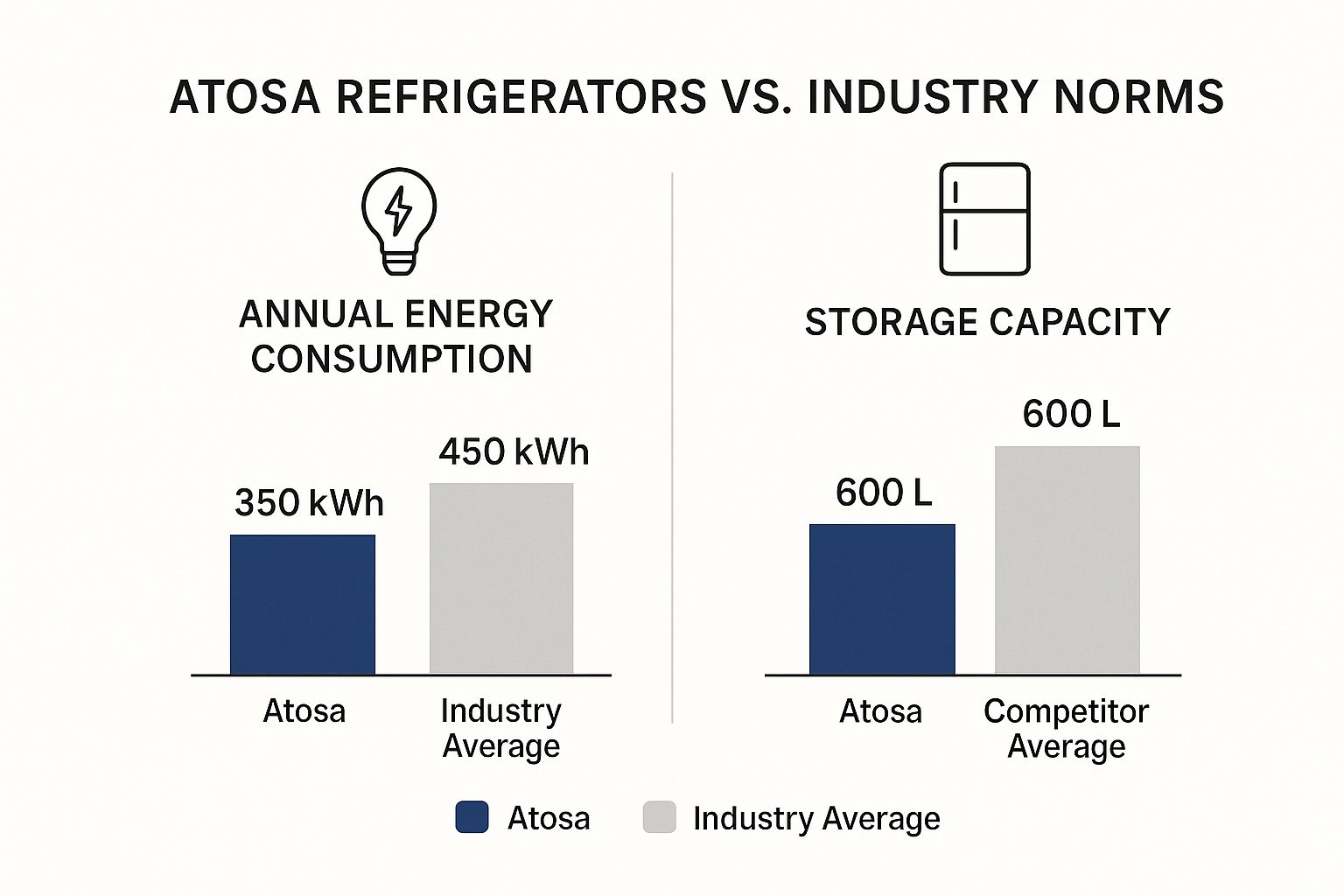
It's clear from the data that Atosa refrigerators don't just provide excellent storage capacity; they also operate more efficiently, which translates directly into lower energy bills for your business.
The Versatile Worktop and Prep Table
Worktop and prep table refrigerators take the undercounter concept and kick it up a notch by merging chilled storage with a durable work surface. This two-in-one functionality is a lifesaver in tight kitchens where every square inch is valuable real estate. A worktop unit gives you a solid stainless steel surface for general prep, while a prep table features built-in cutouts for food pans—perfect for an assembly line of sandwiches, salads, or pizzas.
Picture a high-volume deli. With a refrigerated prep table, a single employee can build sandwiches at lightning speed because all the meats, cheeses, and toppings are chilled and organized right in front of them. This seamless integration of cold storage and workspace slashes wasted motion and dramatically speeds up service. It turns a multi-step task into one fluid movement.
Choosing Your Atosa Model: A Comparison
Deciding between these excellent options comes down to your kitchen's specific needs. This table breaks down the primary use for each model to help you visualize where they fit best.
| Model Type | Primary Use Case | Key Feature | Ideal Kitchen Type |
|---|---|---|---|
| Reach-In Refrigerator | Bulk back-of-house ingredient storage. | Maximum capacity for raw and prepped items. | Any kitchen with significant inventory needs. |
| Undercounter Refrigerator | Point-of-use storage at prep or service stations. | Compact size, fits under existing counters. | Bars, garde manger, or specific dessert stations. |
| Worktop/Prep Table | Integrated prep station and cold storage. | Combined work surface with refrigerated pan holders. | Delis, sandwich shops, pizzerias, and salad bars. |
Ultimately, the best Atosa refrigerator is the one that feels like it was designed just for your menu and layout. By thoughtfully matching the model to your kitchen's unique demands, you're not just buying equipment—you're making a smart investment in efficiency, organization, and speed that will pay off for years to come.
Protecting Your Investment with Proper Maintenance
An Atosa refrigerator is a real workhorse, built to handle the constant grind of a commercial kitchen. But just like any high-performance piece of equipment, its lifespan and efficiency come down to how well you take care of it. Think of maintenance not as a chore, but as the smartest way to protect your investment, avoid surprise breakdowns, and keep your unit humming along for years.
Honestly, skipping basic upkeep is the fastest way to turn a reliable asset into a costly headache. A little scheduled care can sidestep the most common service calls, slash your energy use, and ensure your food is always stored in a safe, consistently cool environment.
Setting Up for Success From Day One
Proper maintenance starts the second your new Atosa unit rolls through the door. Getting the installation right lays the foundation for a long, trouble-free life. The single most important part of this? Proper ventilation. Your refrigerator's compressor works by pushing heat out into the kitchen. If it can't breathe, it has to work overtime.
This is especially true for bottom-mounted units. Always make sure there's enough clearance around the refrigerator—check the manual, but it's usually a few inches on the sides and back. Pushing the unit flush against a wall or other equipment traps all that heat, forcing the compressor to run non-stop. That means higher energy bills, parts failing sooner than they should, and uneven cooling. All of which are completely avoidable.
A Simple, Actionable Maintenance Schedule
A complicated maintenance plan that no one actually follows is worse than useless. The key is to build a simple, consistent routine that your team can easily fold into their daily and weekly duties. This schedule hits the most critical parts of your Atosa refrigerator.
Here’s a straightforward plan to keep your unit in prime condition:
- Daily Check: Log the temperature when you open and before you close. This creates a performance log and helps you catch issues before you lose product.
- Weekly Cleaning: Wipe down the door gaskets with warm, soapy water. Caked-on food and grease make gaskets brittle, causing them to lose their seal and leak cold air.
- Monthly Inspection: Do a quick clean of the interior, including shelves and walls. This keeps odors from building up and maintains a sanitary space.
- Quarterly Deep Clean: This is the big one—cleaning the condenser coils. Dust and grease act like a thick blanket, insulating the coils and making the compressor overwork. A simple brushing can make a huge difference in efficiency.
A clogged condenser coil can increase a refrigerator's energy consumption by as much as 30%. A quick, 15-minute cleaning every three months pays for itself by lowering your utility bills and extending the life of the compressor.
Focus on the Gaskets and Coils
If you only have time to do two things, make them these: clean the gaskets and the condenser coils. These are the two spots where a little neglect can cause the biggest problems.
Door Gaskets: The gasket is that flexible rubber seal lining the door. With time, it can get brittle, crack, or lose its magnetic pull. A bad seal means your refrigerator is constantly fighting a losing battle with the warm kitchen air. Test it by closing the door on a dollar bill. If you can slide the bill out without any resistance, it's probably time for a new gasket. Thankfully, Atosa gaskets are designed to just press into place, making replacement a quick, tool-free job.
Condenser Coils: As we mentioned, these coils are how your fridge gets rid of heat. They work just like a car's radiator and are usually located with the compressor. In a busy kitchen, they become magnets for airborne dust and grease. Just taking a stiff brush or a vacuum to them every quarter ensures your refrigerator can "breathe" properly. This one simple step can prevent the number one cause of compressor failure.
By putting these straightforward maintenance routines into practice, you give your team ownership over the equipment they use every day. For a complete overview of what to look for when outfitting your kitchen, check out our detailed commercial kitchen equipment checklist. A well-maintained Atosa refrigerator will be a reliable partner in your kitchen's success for years to come.
How Atosa Fits into Modern Refrigeration Trends
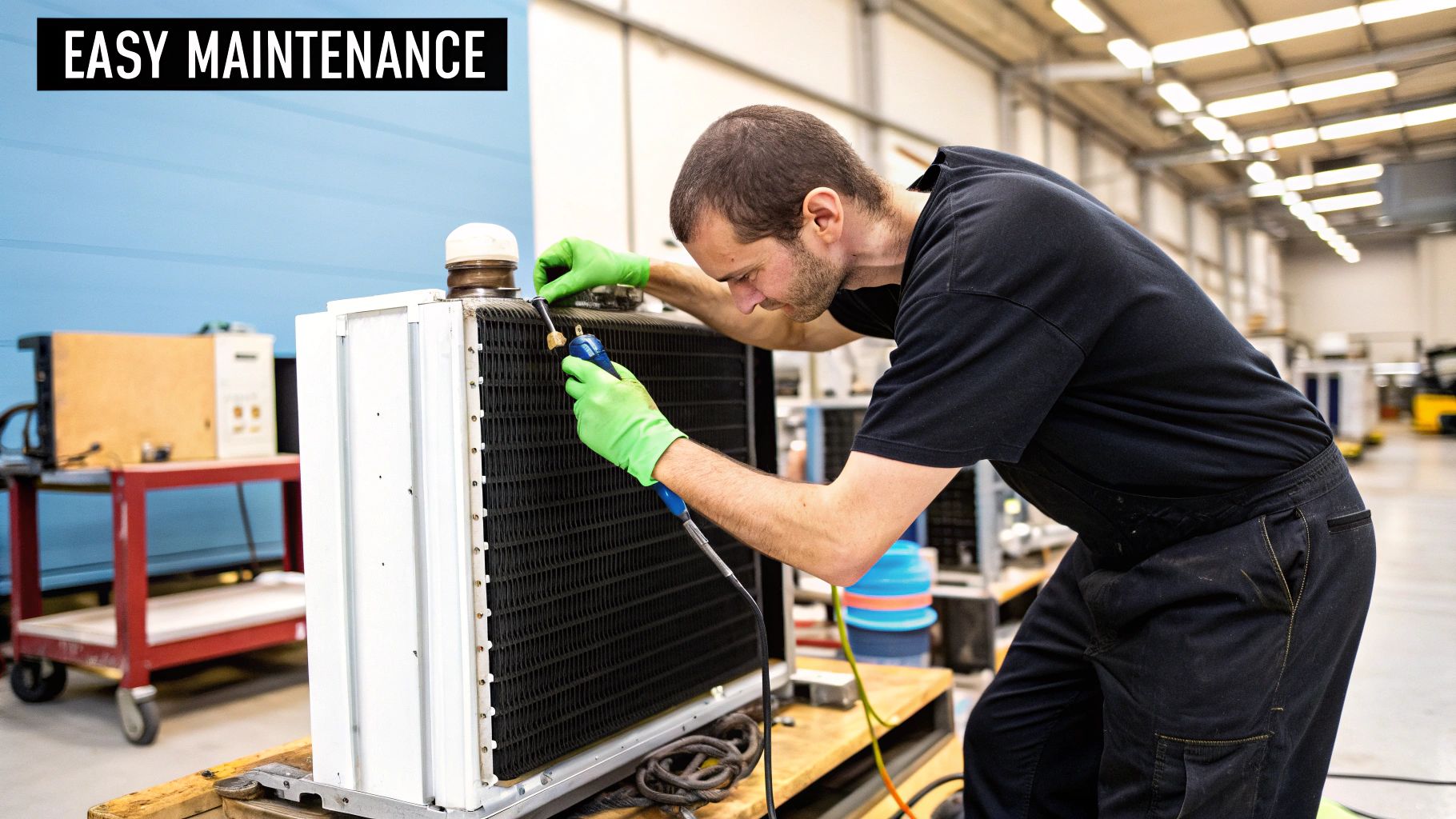 When you're investing in new kitchen equipment, you're not just solving today's problems—you're getting ready for what's coming next. Picking an Atosa refrigerator isn't just about buying a machine; it’s about aligning your business with the biggest trends in commercial refrigeration: sustainability, efficiency, and smart operation.
When you're investing in new kitchen equipment, you're not just solving today's problems—you're getting ready for what's coming next. Picking an Atosa refrigerator isn't just about buying a machine; it’s about aligning your business with the biggest trends in commercial refrigeration: sustainability, efficiency, and smart operation.
Gone are the days when a refrigerator was just an insulated box to keep things cold. Now, it's a vital piece of tech that directly affects your utility bills, environmental footprint, and daily workflow. As industry insiders, we see that Atosa has done a great job of positioning its products right in the middle of these modern shifts, making them a smart, forward-thinking choice for any kitchen.
Embracing Efficiency and Sustainability
One of the biggest waves in the industry is the massive push for energy efficiency and sustainable practices. This isn't just about "going green"—it's a smart business decision. With energy costs on the rise and environmental regulations getting stricter, efficiency has become a top priority for anyone managing a kitchen.
This is an area where Atosa really delivers. A core component of their modern design is the use of R290 refrigerant, a natural, eco-friendly hydrocarbon. This is a big deal for a few key reasons:
- It keeps you compliant: Many jurisdictions have phased out older, more harmful refrigerants. Using R290 means your equipment meets current and future standards.
- It's more efficient: R290 refrigerant is better at absorbing heat, so the compressor doesn't have to work as hard or as often. That translates directly to lower electricity bills.
- It's better for the planet: Compared to old-school refrigerants, R290 has a very low Global Warming Potential (GWP), which shrinks your kitchen's carbon footprint.
By choosing an Atosa refrigerator with R290, you are making a conscious decision to lower operational costs and build a more sustainable business. It’s a win for your bottom line and for the environment.
The global demand for smarter, more efficient refrigeration is exploding. The international refrigerator market, valued at roughly $74.74 billion, is expected to reach $120.01 billion by 2032, driven largely by the same smart technology and energy-saving designs that Atosa builds into its units. These features, like digital controls and green refrigerants, help kitchens meet tough environmental laws worldwide. For a deeper look at these global trends, you can explore detailed forecasts on the refrigerator market.
Smart Technology as a Standard Feature
The other major trend shaking up the industry is the integration of "smart" technology. In a commercial kitchen, this isn’t about your fridge ordering milk for you. It's about precision, data, and having total control. Features that once seemed like high-end luxuries, such as digital controllers, are now must-haves for modern kitchen management.
The Dixell digital controllers standard in every Atosa refrigerator give you pinpoint command over the internal temperature. This is absolutely critical for food safety, as it lets you keep your ingredients within a very narrow, safe temperature range. This level of control drastically reduces spoilage and waste, ensuring you always serve the freshest, safest food possible.
This kind of smart control is a fundamental part of any well-planned kitchen. Integrating advanced equipment thoughtfully is just as important as the physical layout. You can learn more about this in our guide to commercial kitchen design and layout. An Atosa refrigerator doesn’t just sit in the corner; it becomes an active part of an efficient, modern kitchen, giving you the reliability and precision you need to succeed.
Your Atosa Refrigerator Questions, Answered
Even after you've compared all the features and specs, a few practical questions always pop up. It's completely normal. To make sure you're 100% confident with your choice, we’ve put together answers to the most common questions we hear from chefs and restaurant owners about their Atosa refrigerators.
Think of this as your quick-reference guide for those last-minute "what ifs." From warranty coverage to where to find parts down the road, we've got you covered.
What Kind of Warranty Does Atosa Offer?
This is a big one, and thankfully, Atosa's warranty is one of the best in the business. They really stand behind their equipment, which gives you some serious peace of mind.
Most Atosa refrigerators come with a two-year parts and labor warranty. This covers just about everything on the unit. But they take it a step further by offering an additional five-year warranty on the compressor part itself. The compressor is the engine of your fridge, so having that extra coverage shows how much faith Atosa has in its long-term reliability.
Just remember, it's always smart to double-check the specific terms with your dealer when you buy. Sometimes promotions or certain models can have slightly different coverage.
Are Atosa Refrigerators a Pain to Clean and Service?
Not at all. In fact, they're designed with busy kitchens in mind. Atosa knows that if maintenance is complicated, it just won't get done.
- Simple Surfaces: The high-grade stainless steel used inside and out is a breeze to wipe down. It doesn't hold onto stains or smells, which is a huge plus.
- Tool-Free Gaskets: The door gaskets are a "press-in" style. That means when one gets worn out, you can just pull it off and press a new one in by hand. No tools, no fuss. It’s a five-minute job.
- Easy-Access Compressor: The bottom-mounted compressor is a game-changer for maintenance. Your service tech can get to all the important parts without needing a ladder, making routine coil cleaning and repairs much faster and less disruptive to your kitchen's flow.
These thoughtful design choices mean daily cleaning is easy for your team, and any professional service calls will be quicker and cheaper.
Can I Put an Atosa Commercial Refrigerator in My Garage?
I get this question a lot, and the answer is a firm no. You really shouldn't use a commercial refrigerator in a home setting. It might seem like a great idea for extra storage, but these machines are built for a completely different world.
A commercial unit like an Atosa model kicks out a lot more heat and noise than a residential fridge. It's also built to different electrical standards and needs serious ventilation to work properly. If you stick one in an enclosed garage, you'll face sky-high energy bills, poor performance, and even potential safety hazards. On top of all that, putting an Atosa fridge in a home will void the warranty instantly.
Choosing the right tool for the job is everything. An Atosa commercial refrigerator is a workhorse designed for the heat of a professional kitchen, but it’s simply not built for residential life.
Where Can I Buy Atosa Refrigerators and Find Parts?
Finding an Atosa unit is easy. They're sold through a huge network of authorized restaurant equipment dealers all over the country, both in showrooms and online.
When you eventually need replacement parts—like a new shelf, a door gasket, or a thermostat—your first call should be to the dealer you bought the unit from. They’ll know exactly what your model needs. You can also find certified parts at major online restaurant supply stores, which is great for ensuring you get components that meet the factory specs.
This accessibility is a big part of why Atosa is so popular. The brand is tapping into a massive global trend. The refrigeration market is expected to boom, growing from about $85.6 billion in 2025 to roughly $142.5 billion by 2033. This growth, fueled by urbanization and the explosion of food retail, means that brands like Atosa will continue to have strong support and parts networks for years to come. You can discover more insights about the growing global refrigerator market to see how these trends protect your investment.
Ready to equip your kitchen with a reliable, high-performance Atosa refrigerator? At Encore Seattle Restaurant Equipment, we offer an extensive selection of top-brand appliances at unbeatable prices, backed by expert advice and flexible financing. We're here to help you discover exclusive deals and the latest news on the restaurant equipment and supplies you need.
